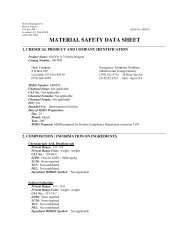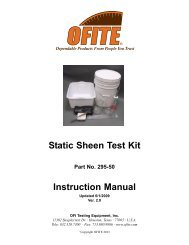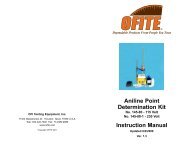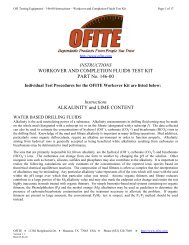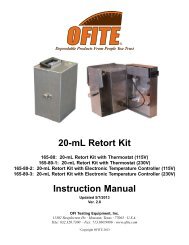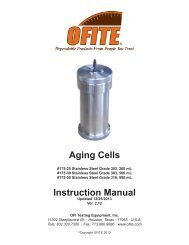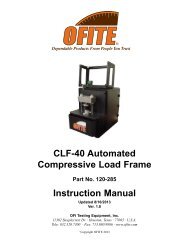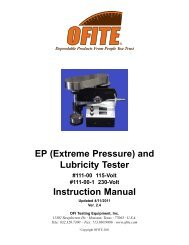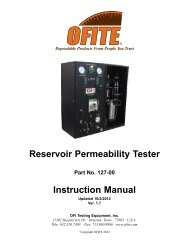120-700 - Corrosion Tester - Instruction Manual - OFI Testing ...
120-700 - Corrosion Tester - Instruction Manual - OFI Testing ...
120-700 - Corrosion Tester - Instruction Manual - OFI Testing ...
You also want an ePaper? Increase the reach of your titles
YUMPU automatically turns print PDFs into web optimized ePapers that Google loves.
HTHP <strong>Corrosion</strong> <strong>Tester</strong><br />
#<strong>120</strong>-<strong>700</strong><br />
<strong>Instruction</strong> <strong>Manual</strong><br />
Updated 8/30/2013<br />
Ver. 2.5<br />
<strong>OFI</strong> <strong>Testing</strong> Equipment, Inc.<br />
11302 Steeplecrest Dr. · Houston, Texas · 77065 · U.S.A.<br />
Tele: 832.320.7300 · Fax: 713.880.9886 · www.ofite.com<br />
©<br />
Copyright <strong>OFI</strong>TE 2013
Table of<br />
Contents<br />
Components......................................................................................2<br />
Specifications ...................................................................................2<br />
Setup..................................................................................................3<br />
<strong>Testing</strong> ...............................................................................................4<br />
Beginning a Test ...........................................................................4<br />
Ending a Test................................................................................6<br />
Appendix ...........................................................................................7<br />
Temperature Controller.................................................................7<br />
Timer...........................................................................................10<br />
Maintenance................................................................................11<br />
<strong>OFI</strong>TE, 11302 Steeplecrest Dr., Houston, TX 77065 USA / Tel: 832-320-7300 / Fax: 713-880-9886 / www.ofite.com 1
Components<br />
#<strong>120</strong>-<strong>700</strong>-1 Spare Parts for One Year (Individual components can be<br />
ordered separately.)<br />
#<strong>120</strong>-001 Mineral Oil, 1 gal, Qty: 4<br />
#<strong>120</strong>-90-008 Breaker, 15 Amp, 2 Pole<br />
#<strong>120</strong>-<strong>700</strong>-011 Pressure Release Valve<br />
#<strong>120</strong>-<strong>700</strong>-012 Air to Cylinder Valve<br />
#<strong>120</strong>-<strong>700</strong>-016 Thermocouple Assembly, Qty: 2<br />
#<strong>120</strong>-<strong>700</strong>-018-1 O-ring, Viton, Qty: 6<br />
#<strong>120</strong>-<strong>700</strong>-020 Sample Jar, Qty: 12<br />
#<strong>120</strong>-<strong>700</strong>-021 Sample Jar Lid, Qty: 12<br />
#<strong>120</strong>-<strong>700</strong>-023-1 Heater<br />
#122-052 Rupture Disk, 5,500 PSI (37.9 MPa), Qty: 4<br />
Specifications<br />
Maximum Temperature:<br />
Maximum Pressure:<br />
Sample Capacity:<br />
400°F (204°C)<br />
For temperatures above 350°F (176°C), new<br />
Viton o-rings will be required after every test.<br />
5,000 PSI (34.5 MPa)<br />
4 Jars<br />
<strong>OFI</strong>TE, 11302 Steeplecrest Dr., Houston, TX 77065 USA / Tel: 832-320-7300 / Fax: 713-880-9886 / www.ofite.com 2
Setup<br />
1. Carefully remove the instrument from the crate and place in a suitable<br />
location away from high traffic areas.<br />
Make sure all valves are either closed or in the “Off” position.<br />
2. Connect an air or nitrogen source (100 - <strong>120</strong> PSI) to the “Air Supply”<br />
port on the back of the instrument. Also connect the “Water Supply”<br />
and “Water Drain” ports.<br />
All supply ports are 1 ⁄4" female NPT connectors.<br />
!<br />
Important<br />
3. The “WASTE” port should firmly attached to a waste container which is<br />
suitable for handling corrosive fluids.<br />
Fluids that enter the waste container should never be reused.<br />
They will contain acids that may damage the pump and other<br />
important components.<br />
4. Remove the cap from the oil reservoir. Fill the reservoir with white mineral<br />
oil. Use the sight glass located on the right side of cabinet to monitor<br />
the reservoir level. It should be filled to approximately 1 ⁄2" from the<br />
top of the sight glass.<br />
5. Connect the control unit using the large cable supplied with the unit.<br />
The connector ports are located on the back of each cabinet. The connectors<br />
on both ends should be screwed together until they are firmly in<br />
place.<br />
6. Attach the thermocouple cable to both units. The thermocouple connectors<br />
are located on the back of both units.<br />
7. Ensure that all electrical switches are off and plug the unit into a<br />
grounded electrical outlet. The electrical socket is located on the back<br />
of the unit. A 220-VAC, 20-amp power source is recommended.<br />
<strong>OFI</strong>TE, 11302 Steeplecrest Dr., Houston, TX 77065 USA / Tel: 832-320-7300 / Fax: 713-880-9886 / www.ofite.com 3
<strong>Testing</strong><br />
Beginning a Test<br />
1. Before starting a test turn all electrical switches off and close all valves.<br />
Make sure the regulator on the front panel is turned fully counter-clockwise.<br />
2. Prepare the acid solution and pour it into the sample bottles.<br />
3. Add the corrosion inhibitor to the acid and mix.<br />
4. Prepare the corrosion coupons and record the initial weight.<br />
5. Turn the “Main” power switch on. The green light on the front of the<br />
unit will turn on to indicate the power is on.<br />
6. Remove the cap from the test cell and pour mineral oil into the cell to a<br />
depth of 3.5" to 4".<br />
7. Use the up and down arrow keys on the temperature controller to<br />
adjust the set point temperature to 150°F.<br />
8. Turn the “Heat” switch on to pre-heat the mineral oil to 150°F. The<br />
“Heat On” light will come on to indicate that the heaters are engaged.<br />
9. Once the mineral oil is heated to 150°F, add the coupons to the sample<br />
bottles and record the time.<br />
10. Cap the sample bottles with the plastic screw caps. The caps have<br />
holes to allow pressure equilibrium.<br />
11. Place the bottles into the sample rack and place the rack into the test<br />
cell using the lift bail. Remove the lift bail and record the time.<br />
Sample Rack with Bottles<br />
<strong>OFI</strong>TE, 11302 Steeplecrest Dr., Houston, TX 77065 USA / Tel: 832-320-7300 / Fax: 713-880-9886 / www.ofite.com 4
12. Lubricate the cell cap o-ring with petroleum jelly or white lithium grease<br />
and screw the cell cap into the test cell.<br />
13. Open the cell cap plug 1 ⁄4 turn. This will allow air to escape while the<br />
cell fills with mineral oil. Hold a 5 ⁄8" wrench on the nut and be prepared<br />
to tighten it as soon as you see oil leaking form the vent hole in the cell.<br />
Cell Cap<br />
Cell Cap Plug<br />
14. Turn the center valve to “Fill Cell”. Air will force mineral oil from the<br />
reservoir into the test cell.<br />
15. Turn the “Motor” switch on to activate the agitation system.<br />
16. Turn the “Drive Coolant” valve on. The drive coolant keeps the magnetic<br />
drive system cool while the heaters are on.<br />
17. Turn the “Pump” switch on. Apply pressure to the test cell by turning<br />
the regulator clockwise until you reach the desired pressure. <strong>Corrosion</strong><br />
testing is commonly performed at 2,500 ± 500 PSI.<br />
18. Use the up and down arrow keys on the temperature controller to set<br />
the test temperature.<br />
!<br />
Important<br />
While heating the system, the pressure inside the test cell will<br />
increase due to thermal expansion. Maintain the proper test pressure<br />
by slowly opening the “Pressure Release” valve. Once the<br />
cell reaches the final test temperature, the pressure should stop<br />
increasing.<br />
19. Start the test exactly five minutes after the mineral oil reaches the test<br />
temperature. Record the test time, temperature, and pressure at the<br />
start of the test.<br />
<strong>OFI</strong>TE, 11302 Steeplecrest Dr., Houston, TX 77065 USA / Tel: 832-320-7300 / Fax: 713-880-9886 / www.ofite.com 5
<strong>Testing</strong><br />
Ending a Test<br />
1. When the test is complete, turn the “Heat” switch off and set the temperature<br />
control to 32°F.<br />
2. Turn the “Cool” switch on. Do not release the pressure or turn off the<br />
pump until the test cell cools down to 180°F.<br />
3. Once the cell is cool, turn the “Pump” switch off and turn the regulator<br />
completely counter clockwise.<br />
4. Slowly turn the center valve to “Vent” to expell the air.<br />
5. When you no longer hear the air venting, slowly open the “Pressure<br />
Release” valve. The pressure gauge will return to zero.<br />
6. Turn the “Motor” switch off.<br />
7. Turn the “Drive Coolant” valve off.<br />
8. Open the “Air to Cylinder” valve. Air pressure will force mineral oil from<br />
the test cell and out the “Waste” port. When you hear air discharging<br />
from the “Waste” port, close the “Air to Cylinder” valve.<br />
9. Loosen the cell cap plug with a 5 ⁄8" wrench.<br />
10. Unscrew the cell cap from the test cell and remove the sample rack.<br />
11. Remove the corrosion coupons from the sample bottles and neutralize<br />
them in sodium bicarbonate solution. Record the time the coupons are<br />
neutralized.<br />
12. Wash the test cell with ammoniated water.<br />
13. Remove excess fluid from the test cell with paper towels. Dry thoroughly.<br />
14. Pour mineral oil into the cell until it comes to the top of the internal drive<br />
spindle located in the middle of the cell. Replace the cell cap to prevent<br />
foreign objects from entering the cell.<br />
15. Clean and weigh the corrosion coupons. Inspect them for pitting and<br />
record the weight loss and metal condition.<br />
16. Report the inhibitor performance as weight loss (mg) per time exposed.<br />
17. Close all valves and turn all switches off.<br />
<strong>OFI</strong>TE, 11302 Steeplecrest Dr., Houston, TX 77065 USA / Tel: 832-320-7300 / Fax: 713-880-9886 / www.ofite.com 6
Appendix<br />
Temperature Controller<br />
The Eurotherm Model 2404 Temperature Controller is the most important<br />
component of the temperature control system and it is strongly recommended<br />
that operators carefully study the Model 2404 instruction manual<br />
included with the <strong>Corrosion</strong> <strong>Tester</strong>.<br />
If a test requires a custom program, it is important to build and save the<br />
program prior to creating the acid solution and loading the sample bottles.<br />
Below is an example that illustrates how to program the controller. In this<br />
example, you want the test cell to heat to 350° in one hour and hold for<br />
four hours.<br />
Press the “Page” button three times, and you will see “ProG List.” Use the<br />
“Scroll” button to decide which setting to change. Use the arrow buttons to<br />
change the values for that setting.<br />
Temperature Controller<br />
RUN/HOLD<br />
Page<br />
Scroll<br />
<strong>OFI</strong>TE, 11302 Steeplecrest Dr., Houston, TX 77065 USA / Tel: 832-320-7300 / Fax: 713-880-9886 / www.ofite.com 7
For the test described on the previous page, you will want the following settings:<br />
ProG List Setting Explanation<br />
Segn 1 (segment 1)<br />
Type rmp.t (ramp time - other choices include ramp rate<br />
and dwell)<br />
Tgt 350 (final temperature)<br />
Time 60 (reach target temperature in 60 minutes)<br />
Segn 2 (segment 2)<br />
Type Dwell (holds the temperature for the amount of time<br />
chosen for Dur below)<br />
Dur 240 (duration time in minutes)<br />
Segn 3 (segment 3)<br />
Type end This is the last segment<br />
End.t sop Stop the heat<br />
To run the test, push and hold the “Run/Hold” button until the light for Run<br />
turns on. To stop the test, push and hold the “Run/Hold” button until the<br />
light for Run and Hold both turn off. Be sure and turn the “HEAT” switch<br />
off as well.<br />
<strong>OFI</strong>TE, 11302 Steeplecrest Dr., Houston, TX 77065 USA / Tel: 832-320-7300 / Fax: 713-880-9886 / www.ofite.com 8
Temperature Controller Alarm<br />
The temperature controller utilizes a high alarm setpoint which will bring the<br />
unit to an alarm condition if the temperature ever exceeds this value. An<br />
alarm condition is evidenced by the flashing of "1FSH" in the display. In an<br />
alarm condition an audible alarm will sound (if the “Sonalert” switch is on),<br />
the “Alarm” switch will illuminate, the agitation system will stop, and the<br />
pump and heating systems will shut off.<br />
If the thermocouple wire is disengaged an alarm condition will occur.<br />
The high alarm set point is adjusted to 400°F at the factory. To adjust the<br />
high alarm setpoint perform the following.<br />
1. Press the “Page” key four times. “ACCESS” will appear.<br />
2. Press the scroll key once. “CODE” will appear.<br />
3. Press the up arrow once. “1” will appear and change to “PASS”.<br />
4. Press the scroll key once. “GOTO-OPER” will appear.<br />
5. Press the down arrow three times. “FULL” will appear, wait until it<br />
blinks.<br />
6. Press the “PAGE” key six times. “AL-LIST” will appear.<br />
7. Press the scroll key one time. “1FSH” will appear.<br />
8. Use the up and down arrow keys to adjust the alarm setpoint to the<br />
required value.<br />
9. Press the “PAGE” key nine times to return to the default display.<br />
<strong>OFI</strong>TE, 11302 Steeplecrest Dr., Houston, TX 77065 USA / Tel: 832-320-7300 / Fax: 713-880-9886 / www.ofite.com 9
Appendix<br />
Timer<br />
The timer on the <strong>Corrosion</strong> <strong>Tester</strong> controls the auto-cool feature. The timer<br />
begins counting up as soon as the “R” button is pressed. When it reaches<br />
the first setpoint (P1), it turns on the cooling system to cool the cell. When<br />
it reaches the second setpoint (P2), it turns the cooling system off.<br />
In order to safely use the auto-cool feature and timer, the temperature controller<br />
must be programmed with a ramp time, dwell time, and stop (refer to<br />
page 7 for help programming the temperature controller). This is to make<br />
sure the heaters are automatically turned off by the time the cooling system<br />
is turned on.<br />
To do this, set the timer setpoint P1 to the total ramp and dwell time of the<br />
test. Then set P2 to P1 plus the total cooling time. In the example given<br />
on page 7, P1 would be set to 05:00 (one hour for ramp and four hours for<br />
dwell). Then, to cool for one hour, set P2 to 06:00 (five hours for ramp and<br />
dwell plus one hour for cooling).<br />
The temperature controller and the timer operate separately. In this example,<br />
the temperature controller turns on the heaters for five hours and then<br />
shuts them off. Meanwhile, the timer waits for five hours, then turns on the<br />
cooling system for one hour, then shuts it off.<br />
Make sure the “Auto Cool” switch is turned on. This will allow the timer to<br />
control the cooling system.<br />
To program the timer:<br />
1. Press the “1” button to set P1.<br />
2. Press the button below each digit to set that digit to the appropriate<br />
value. Each time you press the button, the digit will increase by one.<br />
The display is in HH.MM format, meaning the first two digits indicate the<br />
number of hours and the last two indicate the number of minutes.<br />
3. When the value is correct, press the “E” button.<br />
4. Press the “2” button to set P2. Repeat steps 2 and 3 to set the value.<br />
<strong>OFI</strong>TE, 11302 Steeplecrest Dr., Houston, TX 77065 USA / Tel: 832-320-7300 / Fax: 713-880-9886 / www.ofite.com 10
Appendix<br />
Maintenance<br />
1. The most important maintenance procedure is cleaning. Be sure to<br />
thoroughly clean the test cell immediately after every test. High-pressure<br />
valves wear quickly when exposed to contaminated fluids containing<br />
particulate matter.<br />
2. The test cell cap threads have been lubricated prior to shipment and<br />
periodically should be re-lubricated.<br />
<strong>OFI</strong>TE, 11302 Steeplecrest Dr., Houston, TX 77065 USA / Tel: 832-320-7300 / Fax: 713-880-9886 / www.ofite.com 11



